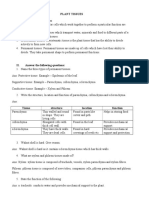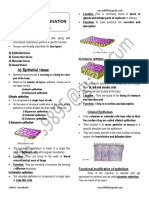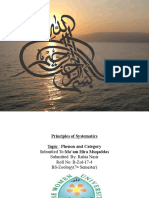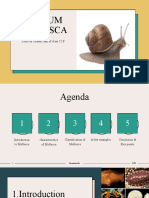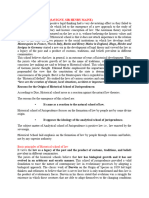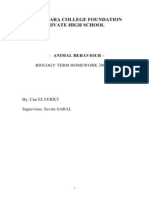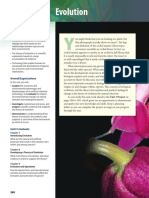100%(1)100% found this document useful (1 vote)
593 viewsA Handbook of Zoology: Book Review
A Handbook of Zoology: Book Review
Uploaded by
Dr A.K. VermaThe popular book entitled ‘A Handbook of Zoology’ is published by Shri Balaji Publications, Muzaffarnagar (U.P.) India in 2015. Its first edition was published in 2012, second edition in 2013, third edition in 2014 and fourth revised updated edition in 2005. The fourth edition of this book of 8+638= 646 pages contains 37 chapters of Zoology in 7 units. Each chapter comprises subject matter in brief, along with point wise description, supported by suitable diagrams and examples. This is followed
Copyright:
© All Rights Reserved
Available Formats
Download as PDF, TXT or read online from Scribd
A Handbook of Zoology: Book Review
A Handbook of Zoology: Book Review
Uploaded by
Dr A.K. Verma100%(1)100% found this document useful (1 vote)
593 views2 pagesThe popular book entitled ‘A Handbook of Zoology’ is published by Shri Balaji Publications, Muzaffarnagar (U.P.) India in 2015. Its first edition was published in 2012, second edition in 2013, third edition in 2014 and fourth revised updated edition in 2005. The fourth edition of this book of 8+638= 646 pages contains 37 chapters of Zoology in 7 units. Each chapter comprises subject matter in brief, along with point wise description, supported by suitable diagrams and examples. This is followed
Copyright
© © All Rights Reserved
Available Formats
PDF, TXT or read online from Scribd
Share this document
Did you find this document useful?
Is this content inappropriate?
The popular book entitled ‘A Handbook of Zoology’ is published by Shri Balaji Publications, Muzaffarnagar (U.P.) India in 2015. Its first edition was published in 2012, second edition in 2013, third edition in 2014 and fourth revised updated edition in 2005. The fourth edition of this book of 8+638= 646 pages contains 37 chapters of Zoology in 7 units. Each chapter comprises subject matter in brief, along with point wise description, supported by suitable diagrams and examples. This is followed
Copyright:
© All Rights Reserved
Available Formats
Download as PDF, TXT or read online from Scribd
Download as pdf or txt
100%(1)100% found this document useful (1 vote)
593 views2 pagesA Handbook of Zoology: Book Review
A Handbook of Zoology: Book Review
Uploaded by
Dr A.K. VermaThe popular book entitled ‘A Handbook of Zoology’ is published by Shri Balaji Publications, Muzaffarnagar (U.P.) India in 2015. Its first edition was published in 2012, second edition in 2013, third edition in 2014 and fourth revised updated edition in 2005. The fourth edition of this book of 8+638= 646 pages contains 37 chapters of Zoology in 7 units. Each chapter comprises subject matter in brief, along with point wise description, supported by suitable diagrams and examples. This is followed
Copyright:
© All Rights Reserved
Available Formats
Download as PDF, TXT or read online from Scribd
Download as pdf or txt
You are on page 1of 2
International Journal of Fauna and Biological Studies 2016; 3(2): 01-02
A Handbook of Zoology: Book Review
ISSN 2347-2677 A.K. Verma has compiled his twenty three years of experience
in this book.
Book reviewed by: The popular book entitled ‘A Handbook of Zoology’ is
Ashok Kumar Verma published by Shri Balaji Publications, Muzaffarnagar (U.P.)
Department of Zoology, India in 2015. Its first edition was published in 2012, second
Govt. P.G. College, edition in 2013, third edition in 2014 and fourth revised
Saidabad Allahabad-221508 (U.P.), India. updated edition in 2005. The fourth edition of this book of
8+638= 646 pages contains 37 chapters of Zoology in 7 units.
Shri Prakash Each chapter comprises subject matter in brief, along with
Department of Zoology, point wise description, supported by suitable diagrams and
K.A.P.G. College, examples. This is followed by sufficient number of objective
Allahabad-211001 (U.P.), India type questions with answer of the same at the end of the page.
Continuous revision and updation into a new improved edition
in every year since its inception undoubtedly demonstrates the
interest of readers, devotion of author as well as publisher and
in turn success of the book.
Unit-I (Diversity in the Living World) describes the
properties of living beings, systematics and rules of taxonomy
including kingdom systems and various phyla from Porifera to
Chordata. In first chapter, an outline of animal classification,
concise description of coelom and salient features of different
phyla are also given. In addition, domestication of animals is
also described. This unit comprises 14 chapters from chapter
1-14 as following:
1. Living Organisms and Systematics
2. Kingdom Protista
3. Phylum 1. Porifera
4. Phylum 2. Coelenterata
5. Phylum 3. Ctenophora
6. Phylum 4. Platyhelminthes
7. Phylum 5. Aschelminthes
8. Phylum 6. Annelida
9. Phylum 7. Arthropoda
10. Phylum 8. Mollusca
11. Phylum 9. Echinodermata
12. Phylum 10. Hemichordata
13. Phylum 11. Chordata
Name of book: A Handbook of Zoology 14. Domestication of Animals
Edition: 4th Unit-II (Histology and Immunology) describes four basic
Year: 2015 types of tissues found in animals namely epithelium,
ISBN: 978-93-84934-08-8 connective, muscular and nervous and integumentary system
Pages: 8+638 including skin and its derivatives. Different types of immunity,
Author: Dr A. K. Verma human immune system, immune response mechanism,
Publisher: Shri Balaji Publications, Muzaffarnagar- antibodies and their types, allergy, inflammation, organ
251001 (U.P.) India transplantation, immunization, ageing, cancer etc. are also
described in this unit. Acquired immuno deficiency syndrome
‘A Handbook of Zoology’ is written to bridge the gap of (AIDS) is described in detail. This second unit comprises 2
availability of proper reading books on the subject especially chapters from chapter 15-16. Names of these chapters are:
National and State level medical entrance examinations. The 1. Animal Tissues and Skin
architecture of the book has strategically arranged to 2. Immune System
strengthen the subjective as well as descriptive skill of the Unit-III (Human Anatomy and Physiology) describes
subject which in turn helpful to improve the confidence and anatomy and physiology of different mammalian systems with
problem solving skills of the students concerned. It provides special reference to human. It comprises 7 chapters from
systematic, well planned up to mark and to the point approach chapter 17-23. These chapters are as following:
incorporating NCERT concept, necessary for students 1. Digestive system
preparing for medical entrance examinations. Its author Dr 2. Respiratory system
~1~
Journal of Entomology and Zoology Studies
3. Circulatory system Unit-VI (Genetics and Biotechnology) describes Mendelian
4. Excretory system genetics, genetical terminology, gene interaction, linkage,
5. Skeletal system crossing over, different types of sex determining mechanisms,
6. Nervous system haploid genetics, human genetics (human karyotype, sex
7. Chemical co-ordination and Regulation determination, sex linked inheritance, sex limited inheritance,
Unit-IV (Human Reproduction) describes reproductive sex influenced inheritance, syndromes, Barr body and Lyon’s
system, physiology of reproduction and embryonic hypothesis, inborn errors, sickle cell disease, ABO blood
development of human. Moreover, reproductive health, grouping, eugenics etc.), molecular biology (DNA, RNA,
infertility and assisted reproductive technologies (ARTs), test replication, flow of genetic information and central dogma,
tube baby, amniocentesis, MTP, sterilization and contraception genetic code, transcription, teminism, translation, regulation,
(birth control measures) are also a part of this unit. Different mutation etc.). Moreover, genetic engineering, biotechnologies
types of birth control measures are nicely represented in are also described with processes and applications. This last
tabular form. It comprises 3 chapters from chapter 24-26 unit comprises 4 chapters from chapter 32-35 as following:
namely: 1. Genetics
1. Reproduction 2. Human Genetics
2. Embryonic Development 3. Molecular Biology
3. Reproductive Health 4. Processes and Applications of Biotechnology
Unit-V (Origin and Evolution of Life) describes how life is Unit-VII (Exam Question Paper) incorporates memory based
originated on the earth. Theories and evidences of organic CPMT 2015 question paper containing 50 questions of
evolution, geological time scale, human evolution, population Zoology. The questions are followed by answers. This unit
genetics, genetic drift, speciation, different types of natural also contains AIPMT 2015 question paper having 50 questions
selection etc. are included in this unit. It comprises 5 chapters of Zoology. These questions are followed by answers too.
from chapter 27-31: The handbook reviewed above is therefore up-to-date and
1. Origin of Life ultimate on the subject. Anyone can understand Zoology with
2. Theories and Evidences the help of this book and can get success in completion easily
3. Geological Time Scale as it comprises a lot of valuable, useful and updated material to
4. Human Evolution subject as well, as objective type questions in simple language.
5. Population Genetics and Natural Selection
~2~
You might also like
- Hick - Arguments For The Existence of God PDFDocument163 pagesHick - Arguments For The Existence of God PDFSG100% (1)
- Turtle Dissection PDFDocument7 pagesTurtle Dissection PDFDemetra AlbescuNo ratings yet
- (Lewis I. Held JR) Quirks of Human Anatomy An Ev PDFDocument273 pages(Lewis I. Held JR) Quirks of Human Anatomy An Ev PDFNancy Morales100% (2)
- Amino Acid Sequences and Evolutionary RelationshipsDocument6 pagesAmino Acid Sequences and Evolutionary RelationshipsAbby Gail DigalNo ratings yet
- MSC ZoologyDocument183 pagesMSC ZoologyShruti VermaNo ratings yet
- Characteristics of Phylum Porifera (Sponges)Document15 pagesCharacteristics of Phylum Porifera (Sponges)Pralex PrajapatiNo ratings yet
- Plant - Tissue NotesDocument3 pagesPlant - Tissue NotesDikshit Rishi JainNo ratings yet
- +1 Zoology Focus Area NotesDocument85 pages+1 Zoology Focus Area NotesKhatarnakNo ratings yet
- Acoelomate Bilateral AnimalsDocument31 pagesAcoelomate Bilateral AnimalsHirendra GurnaniNo ratings yet
- Dichotomous KeyDocument10 pagesDichotomous KeyjajajaNo ratings yet
- Digestive System Part 1Document10 pagesDigestive System Part 1bazingaNo ratings yet
- Ecology and Systematic Zoology Advanced Animal EcologyDocument27 pagesEcology and Systematic Zoology Advanced Animal EcologyMamila TadNo ratings yet
- Zoology 100 Notes 1Document8 pagesZoology 100 Notes 1Bethany Jane Ravelo IsidroNo ratings yet
- Identification of Invertebrate Taxonomic CharacterDocument8 pagesIdentification of Invertebrate Taxonomic CharacterFitria RamadhaniNo ratings yet
- Annelids and MolluscsDocument82 pagesAnnelids and MolluscsHawltu MuluNo ratings yet
- Animal KingdomDocument22 pagesAnimal KingdomdellfrogNo ratings yet
- Lecture 1 Introduction To Systematic BiologyDocument21 pagesLecture 1 Introduction To Systematic BiologyElizabeth Sherrill MojicaNo ratings yet
- Tamil Nadu Class 12 - Bio-Zoology-Zoology - English Medium - Possible 5 Mark Questions With Answer.Document34 pagesTamil Nadu Class 12 - Bio-Zoology-Zoology - English Medium - Possible 5 Mark Questions With Answer.revamanian57% (7)
- Shaha, Tal. Sinnar, Dist. Nashik: S.D.Jadhav English Medium SchoolDocument62 pagesShaha, Tal. Sinnar, Dist. Nashik: S.D.Jadhav English Medium SchoolGanesh PatilNo ratings yet
- 1.6 The Five Kingdoms of LifeDocument4 pages1.6 The Five Kingdoms of LifeRanjith RajaramNo ratings yet
- Echinodermata Classification N CharactersDocument34 pagesEchinodermata Classification N Charactersyayeg rajaNo ratings yet
- Animal Diversity 1 PDFDocument20 pagesAnimal Diversity 1 PDFRica Jane Delan MapaloNo ratings yet
- Z P Cristobal TaxonomyDocument68 pagesZ P Cristobal Taxonomyleryc mdlNo ratings yet
- Body SymmetryDocument1 pageBody SymmetryCyanDesNo ratings yet
- Ncert: Mbbs (Kgmu)Document23 pagesNcert: Mbbs (Kgmu)NITINNo ratings yet
- Phylum PlatyhelminthesDocument11 pagesPhylum PlatyhelminthesasajumuthmainahNo ratings yet
- S. S. Jain Subodh PG (Autonomous) College Rambagh Circle, Jaipur - 302004Document43 pagesS. S. Jain Subodh PG (Autonomous) College Rambagh Circle, Jaipur - 302004rahulvikiNo ratings yet
- Phylogeny CladisticsDocument46 pagesPhylogeny CladisticsJoseph FerreiraNo ratings yet
- 8 Current Approaches in TaxonomyDocument9 pages8 Current Approaches in TaxonomyDheeraj K VeeranagoudarNo ratings yet
- Prepared By: Shella Mae N. Mainit MSF-1Document44 pagesPrepared By: Shella Mae N. Mainit MSF-1Chriseil arts tancioNo ratings yet
- Evolution of MetamerismDocument3 pagesEvolution of MetamerismBs JanNo ratings yet
- Worksheet Phylum MolluscDocument3 pagesWorksheet Phylum MolluscMavel Madih Kumchu100% (1)
- Plecoptera: ID. NO. 2017030041Document14 pagesPlecoptera: ID. NO. 2017030041Sailakshmi100% (1)
- Phylum PoriferaDocument17 pagesPhylum PoriferaRhiZhal SquDetto FrizTalNo ratings yet
- Art Infusion: Ideal Conditions For STEAMDocument7 pagesArt Infusion: Ideal Conditions For STEAMShujat AliNo ratings yet
- Chapter-03 Structural Organisation in Animals: Animal TissueDocument5 pagesChapter-03 Structural Organisation in Animals: Animal TissueAravind Shabu100% (1)
- History of Animal Taxonomy v2Document5 pagesHistory of Animal Taxonomy v2Cristie SumbillaNo ratings yet
- Laporan PKL Ektum FixDocument141 pagesLaporan PKL Ektum FixSriayu JootjelopoNo ratings yet
- Presentation Phenon N CategoryDocument19 pagesPresentation Phenon N CategorySohaib NasirNo ratings yet
- 9.2 Speciation - How Species Form (HW Worksheet)Document4 pages9.2 Speciation - How Species Form (HW Worksheet)Shaun AhujaNo ratings yet
- Laporan Praktikum Taksonomi Vertebrata RDocument10 pagesLaporan Praktikum Taksonomi Vertebrata RMuhammad Fahreza Rizky WNo ratings yet
- The 12 Steps Muscle ContractionDocument1 pageThe 12 Steps Muscle ContractiongraceNo ratings yet
- Phylum Ctenophora KJC PDFDocument31 pagesPhylum Ctenophora KJC PDFEthylNo ratings yet
- Plant SystematicsDocument36 pagesPlant SystematicsIrfan Gul100% (1)
- Zoology 2008Document91 pagesZoology 2008Ajmal Khan0% (2)
- ZOOLOGY (First PAPER) (Structure and Functions of Invertebrate Types)Document2 pagesZOOLOGY (First PAPER) (Structure and Functions of Invertebrate Types)GuruKPO0% (1)
- Modern Trends in TaxonomyDocument38 pagesModern Trends in TaxonomyDheeraj K VeeranagoudarNo ratings yet
- Crustaceae Larval Forms PDFDocument12 pagesCrustaceae Larval Forms PDFAfridi ShaikhNo ratings yet
- Gnathiferans and Smaller LophotrochozoansDocument36 pagesGnathiferans and Smaller LophotrochozoansLiz Hackett100% (1)
- Keanekaragaman - Tumbuhan HewanDocument25 pagesKeanekaragaman - Tumbuhan HewanMochamad Sabilal MuhtadinNo ratings yet
- Anatomical Features of BougainvilleaDocument15 pagesAnatomical Features of BougainvilleaBella ReadNo ratings yet
- PoriferaDocument33 pagesPoriferaRushikesh pawar100% (1)
- Systematic Approaches To Phylogeny)Document26 pagesSystematic Approaches To Phylogeny)Mhi Ismail100% (1)
- SystematicsDocument31 pagesSystematicsmanojtbgri5793No ratings yet
- Circulation in AnnelidaDocument2 pagesCirculation in AnnelidaNarasimha Murthy100% (1)
- Zoology Notes: 009 Chapter 5Document4 pagesZoology Notes: 009 Chapter 5humanupgrade100% (1)
- Chlorophyta VolvoxDocument6 pagesChlorophyta VolvoxArista Novi Hana PratiwiNo ratings yet
- PHYLUM MolluscaDocument10 pagesPHYLUM MolluscaShawn SamNo ratings yet
- Vertebrates: Comparative Anatomy, Function, Evolution. - Kenneth V. Kardong. 1998. Second Edition. Mcgraw-Hill, Boston, MassachusettsDocument3 pagesVertebrates: Comparative Anatomy, Function, Evolution. - Kenneth V. Kardong. 1998. Second Edition. Mcgraw-Hill, Boston, MassachusettsMinnie chanNo ratings yet
- Zoology Chapter 4Document67 pagesZoology Chapter 4Driver Hafizur RahmanNo ratings yet
- The Living WorldDocument11 pagesThe Living Worldananthiaselvi974No ratings yet
- Limnological Studies of Semara Taal, A Wetland of District Siddharthnagar, Uttar Pradesh, IndiaDocument5 pagesLimnological Studies of Semara Taal, A Wetland of District Siddharthnagar, Uttar Pradesh, IndiaDr A.K. VermaNo ratings yet
- Nesting Behaviour and Current Threats To The Indian Sarus Crane Around Alwara Lake of District Kaushambi (U.P.), India.Document7 pagesNesting Behaviour and Current Threats To The Indian Sarus Crane Around Alwara Lake of District Kaushambi (U.P.), India.Dr A.K. VermaNo ratings yet
- Ecological Balance: An Indispensable Need For Human SurvivalDocument3 pagesEcological Balance: An Indispensable Need For Human SurvivalDr A.K. VermaNo ratings yet
- Necessity of Ecological Balance For Widespread BiodiversityDocument3 pagesNecessity of Ecological Balance For Widespread BiodiversityDr A.K. VermaNo ratings yet
- Position of Protozoa in Five Kingdom SystemDocument3 pagesPosition of Protozoa in Five Kingdom SystemDr A.K. VermaNo ratings yet
- Studies On Use of Local Medicinal Flora in Nest Building by Threatened Bird, Grus Antigone Kaushambi (U.P.), IndiaDocument7 pagesStudies On Use of Local Medicinal Flora in Nest Building by Threatened Bird, Grus Antigone Kaushambi (U.P.), IndiaDr A.K. VermaNo ratings yet
- Environmental Ethics: Need To RethinkDocument3 pagesEnvironmental Ethics: Need To RethinkDr A.K. VermaNo ratings yet
- Effect of Arsenic On Lipid Metabolism of A Fresh Water Cat Fish, Mystus VittatusDocument3 pagesEffect of Arsenic On Lipid Metabolism of A Fresh Water Cat Fish, Mystus VittatusDr A.K. VermaNo ratings yet
- Antigone Antigone in and Around Alwara Lake of DistrictDocument4 pagesAntigone Antigone in and Around Alwara Lake of DistrictDr A.K. VermaNo ratings yet
- Evolution, Merits and Demerits of Five Kingdom SystemDocument3 pagesEvolution, Merits and Demerits of Five Kingdom SystemDr A.K. VermaNo ratings yet
- Status and Ecology of Indian Sarus Crane, Grus Antigone Antigone in and Around The Alwara Lake of District Kaushambi (U.P.)Document5 pagesStatus and Ecology of Indian Sarus Crane, Grus Antigone Antigone in and Around The Alwara Lake of District Kaushambi (U.P.)Dr A.K. VermaNo ratings yet
- Impact of Arsenic On Carbohydrate Metabolism of A Fresh Water Cat Fish, Mystus VittatusDocument3 pagesImpact of Arsenic On Carbohydrate Metabolism of A Fresh Water Cat Fish, Mystus VittatusDr A.K. VermaNo ratings yet
- Comparative Analysis of Sarus Crane Population From 2012-2019 in and Around Alwara Lake of District Kaushambi (U.P.), IndiaDocument4 pagesComparative Analysis of Sarus Crane Population From 2012-2019 in and Around Alwara Lake of District Kaushambi (U.P.), IndiaDr A.K. VermaNo ratings yet
- Anomalies in Biochemical Constituents of Kidney in Arsenic Induced Mystus VittatusDocument5 pagesAnomalies in Biochemical Constituents of Kidney in Arsenic Induced Mystus VittatusDr A.K. VermaNo ratings yet
- The Spandrels of San Marco and The Pang PDFDocument7 pagesThe Spandrels of San Marco and The Pang PDFSebastián LomelíNo ratings yet
- Historical SchoolDocument8 pagesHistorical Schoolalishaneeru2102No ratings yet
- Cultural Evolution of Music PreprintDocument36 pagesCultural Evolution of Music PreprintKhanyisile FakuNo ratings yet
- Malika Kurs IshiDocument46 pagesMalika Kurs Ishibatirovamalika20No ratings yet
- Content SOI2013FinalNewDocument226 pagesContent SOI2013FinalNewrevetronNo ratings yet
- Longevity Among Hunter-GatherersDocument46 pagesLongevity Among Hunter-GatherersTomasz IgnasiakNo ratings yet
- Advanced Theory and Practical Experiences: Evolutionary Project ManagementDocument11 pagesAdvanced Theory and Practical Experiences: Evolutionary Project ManagementCimpoesu DanielaNo ratings yet
- Animal BehaviorDocument35 pagesAnimal BehaviorCanjui0% (1)
- Problemática Ambiental o La Parábola Del Bebé CósmicoDocument8 pagesProblemática Ambiental o La Parábola Del Bebé CósmicoKaterine CalderonNo ratings yet
- Wright and Wrong - Review of Robert Wright's ''The Moral Animal - Why We Are The Way We Are'' (1995) by Richard LynnDocument3 pagesWright and Wrong - Review of Robert Wright's ''The Moral Animal - Why We Are The Way We Are'' (1995) by Richard Lynnno contractNo ratings yet
- Occ Week 14 Principles of Speech According To Delivery ManuscriptDocument18 pagesOcc Week 14 Principles of Speech According To Delivery ManuscriptTeyangNo ratings yet
- Landscape Architecture TheoryDocument133 pagesLandscape Architecture TheoryOana Simona82% (17)
- ERQ Paper 1Document27 pagesERQ Paper 1Phương Anh Cao HoàngNo ratings yet
- NG Ha Inv3 I-CheckDocument4 pagesNG Ha Inv3 I-CheckHOANG DUONG KHONGNo ratings yet
- Evaluation of Proposed Genetic Goals and Targets For The Convention On Biological DiversityDocument6 pagesEvaluation of Proposed Genetic Goals and Targets For The Convention On Biological Diversity07gymsgestureNo ratings yet
- SCIENCE MELC Grade 7 10Document14 pagesSCIENCE MELC Grade 7 10veronica.cutayanNo ratings yet
- Evolution - Biology Form 4 Topical Questions and AnswersDocument8 pagesEvolution - Biology Form 4 Topical Questions and AnswersKevin KiplangatNo ratings yet
- Evolution Quiz1Document2 pagesEvolution Quiz1api-236443418No ratings yet
- Grade 10 Budget of Work ScienceDocument4 pagesGrade 10 Budget of Work ScienceJackie Lou AriasNo ratings yet
- Proposal For An Allele Nomenclature System Based On The Evolutionary Divergence of HaplotypesDocument10 pagesProposal For An Allele Nomenclature System Based On The Evolutionary Divergence of HaplotypesRoxana ElenaNo ratings yet
- Chapter 7 PDFDocument36 pagesChapter 7 PDFax1leNo ratings yet
- ISO-PC302 N0050 Italian PresentationDocument20 pagesISO-PC302 N0050 Italian PresentationmcbalzanNo ratings yet
- Speciation 1st Edition Jerry A. Coyne all chapter instant downloadDocument55 pagesSpeciation 1st Edition Jerry A. Coyne all chapter instant downloaddupaymellssiNo ratings yet
- Coalescing Minds: Brain Uploading-Related Group Mind ScenariosDocument22 pagesCoalescing Minds: Brain Uploading-Related Group Mind Scenariosరఘువరన్ రెడ్డి జూలకంటిNo ratings yet
- Lecture 1, Introduction To Social SciencesDocument3 pagesLecture 1, Introduction To Social SciencesDIANA MWANGI100% (2)
- A Review of The Principia Cybernetica Project HeylighenDocument34 pagesA Review of The Principia Cybernetica Project HeylighenAn RoyNo ratings yet
- DNA ChangesDocument4 pagesDNA Changesskymate64No ratings yet







